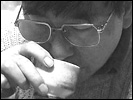Homemade Sake
- Year
- 2001
- Original title
- Danchizake
- Japanese title
- 団地酒
- Director
- Running time
- 49 minutes
- Published
- 23 April 2003

by Tom Mes
The proliferation of DV technology, and more importantly the acceptance of it as a valid medium for filmmaking, has had a diverse effect on the film industry in these past years. From the creation of Sony and Panasonic's "professional" digital cameras as used by the likes of George Lucas, Robert Rodriguez, Takashi Miike, and Kiyoshi Kurosawa, whose images are virtually indistinguishable from those of regular 35mm cameras, to brazenly experimental but often misfired works by established directors like Steven Soderbergh, Hal Hartley, Lars von Trier, and Mike Figgis.
Then of course there is the democratisation of cinema afforded by the cheaper medium of DV, which allows independent filmmakers to express themselves and have their work seen by audiences. Not all of them manage to make the best of the opportunities presented by the medium, and more than a few who are now in a position to make films would be better advised to leave it be. However, there are also different voices springing up, voices belonging to young filmmakers, more than a few of whom make themselves heard through the documentary format.
DV is perhaps the ultimate documentary-friendly medium. Small, light, manoeuvrable, and with built-in sound recording, they lower the impact of the filmmaker's presence on his subject. No need for film crews and more opportunity to actually record reality without influencing it. (One result of this is that DV footage is interpreted as communicating a certain realist truth, a characteristic that some Japanese filmmakers have used to their advantage in playing with their viewers, with Miike's Visitor Q and Kenji Murakami's Tel-Club as prime examples.)
The easy handling of DV is a great advantage for any filming done in people's homes, and it's not by accident that recent years have seen quite a number of digitally-shot, low-budget documentaries about home life. Though the risk of tedium and navel-gazing looms large, some of these have expressed a viewpoint that is at once very personal but that at the same time reflects certain aspects of society as a whole. 23-year-old Tetsuaki Matsue's Annyong Kimchee (1999) was set in grandfather's kitchen for a telling account of Koreans in Japan. 25-year-old Takahiro Kobayashi's Home (2001) laid bare some of the social problems at the source of hikikomori or voluntary isolation, a phenomenon particularly prevalent among young men in their late twenties, one of them being the filmmaker's older brother.
Homemade Sake, directed by Satoshi Ono (24), is closely related to these two films. Made, like Annyon-Kimchi and Home, as a graduation piece by a film student, it is set in the apartments of the director's separated parents and delivers an equally impressive portrait of one of the hidden aspects of life in contemporary Japan.
Ono films his father, an out-of-work artist and alcoholic, as he goes about brewing his own sake. Having no source of income, this is the father's only way to continue procuring and drinking alcohol. Filming the painstaking and elaborate procedure with an attention to detail that mirrors his father's own devotion, Ono follows every step of the brewing process, which requires few ingredients but lots of patience.
While the substance ferments in the refrigerator, Ono's father returns to his easel and the canvas he paints with equal amounts of care and attention. These moments are intercut with the filmmaker's visits to his mother, who lives in a different apartment in the same housing complex (the Japanese title Danchizake translates as 'housing complex sake'). It's during this visit that we get to learn some of the family history, but the mother's reminiscences are anything but nostalgic and romantic. When she recalls first meeting her husband in university, she mainly remembers that "he was extremely drunk". In passing she reveals that since their separation she has stopped financially supporting her husband and that he survives by borrowing money and never paying back the loans.
The two families portrayed in Homemade Sake and Kobayashi's Home share some striking similarities. In both cases the father is a shadow of the paternal head of the family he is traditionally supposed to be, while the mother has attempted to take over this role as well as she could, but has slowly drifted into despair. This pattern of the disintegration of the nuclear family unit is something that has been signalled not only by Japanese documentarists, but also by fiction filmmakers. Shinji Aoyama, Takashi Miike, Kiyoshi Kurosawa, and Kinji Fukasaku, to name but a few, have all referred to it in recent films, which indicates its widespread impact. It's no surprise then that it should be such a common subject among filmmakers in their early twenties like Ono, who have experienced these problems firsthand in their own families.
But Homemade Sake also reveals a good deal of nuance. Ono's parents never officially divorced. When he asks his mother why she would stay married to a man she lives apart from and whom she has no financial ties with, her answers witness a good deal of admiration for her husband's determination. She is willing to look beyond his shortcomings, says that "despite his complete inability to make money, he is very good at taking care of himself", and finally sums up the situation by saying: "I guess this is our own unique way of sharing our lives." They may not live up to the social ideal, but they seem to be at peace with their condition.
With its zero budget, Homemade Sake is admittedly rough around the edges. It's a home movie in every sense of the word, but this also constitutes its very validity as a documentary. There is an incredible sense of spontaneity here, a spontaneity that results in a film that has value beyond the narrow confines of cinema. And not just in teaching us how to make our own sake.